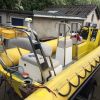OK, in the interests encouraging Nathan, and to give him some more technical detail, here is how I would tackle the job. It sounds a lot, but once you get into it, it will not take very long.
IF I was doing this I would first make sure that I could get to the damaged area on the inside of the hull. If I could do this without lifting the console - result

I would cut the deck to access this area. As Pete says, put this piece to one side as you will need to re-fit it later on. It is my view that you will need to do this to get adequate access to the damaged area, you need to assess this.
Get hold of some kind of grinder, and ground away at an area 4" to 6" either side of the damage. You need to grind away any flow coat (white stuff!) or other surface dis-colouration to expose the glass strands. At a pinch a stiff rotary wire brush could also be used for this, but I find that the bits of wire flying off can get into some really annoying places

I think that it is fairly safe to assume that a contributor to this hull failure is an 'economical' lay up, so I would now try to gauge the thickness of the hull in the area of the damage. What I would try to achieve is a new lay-up that is 2 to 2.5 times the original hull thickness, but a minimum of 1.5 inches. You will need to try to get a datum for this, markings on the inside of the hull with a straight edge between or similar, can be used to measure the thickness of the new matting, as the depth of the mat is difficult to judge when laying it in.
Having cleaned up the inside of the hull you need to cover over the split on the outside of the hull, basically to stop resin dripping through. I would tape on some polyester sheet, but anything that the resin will not adhere to should be fine.
I would use 600gram CSM mat, others might have different views. The greater part of the strength of the finished layup comes not from the resin but from the glass fibres embedded in the resin. So a good idea is to use a roller, to squidge out excess resin; I find a grooved roller squidges the mat better. You can get these from CFS. Often the resin squidged out from one layer is enough to thoroughly 'wet out' the next layer, depending on how generous you are when you apply the resin.
Cut pieces of the matting to fit the area that you have cleaned up. Have these ready to hand when you start applying the resin. Now mix the resin. I normally use a 2% mix, 2 cc of catalyst in 100cc of resin. Do not mix much more than 0.5 litres of resin at one go, as you may find it going off before you can apply it, depending on the temperature.
A good idea is to get a box of the cheap disposable gloves that most pharmacies sell, saves a lot of hand scrubing later on.
I use cheap paint brushes to apply the resin, but I have heard of all sorts of applicators, even chopped up sponge!
Lay your first piece of mat on the prepared area and wet it out with the resin. You will find that the mat will start to come apart as the resin soaks in, this is expected, the glass fibres of the mat are only loosely held together by a binding agent, which dissolves in the resin. Roller this mat to ensure intimate contact with the old glass fibre, and to squidge out excess resin.
Now lay on one piece of matting after another to the required depth, rollering each piece of matting once it is mostly 'wet out'. Do not worry if the resin of the lower layers starts to 'go off', it remains chemically active, and thus you can form a good bond to it, for a few days! I would make the matting of the lower layers wider than the upper layers, to produce a rounded mound effect, but maintain a sensible thickness across the split in the upper layers. As Pete mentioned, this job does not have to be pretty, just pretty strong

To finish off the job properly, apply a liberal application of flowcoat (gelcoat with wax in it) to your masterpiece. And there you have it, the important bit of the job is done.
All you now have to do is close off the deck, finish off the outer surface of the hull, and apply seawater, preferably at no less than 20 knots

So things you need for this job are,
1. Some form of saw to cut into the deck, rotary, jigsaw, or even at a pinch hand saw

2. A grinder, either an angle grinder or at a pinch a grinding wheel and arbour in a pwer drill, although these are difficult to get hold of these days
3. 600 gram CSM mat
4. Polyester resin and catalyst
5. Flowcoat. I would suggest you get the pre-mixed stuff, saves messing about
6. Polyester sheet or similar to temporarily close off outer surface of hull
7. Self adhesive tape for above
8. Gelcoat to finish off outer surface of hull
9. Wet and dry for outer hull surface finishing off
I can give you more detail on how I would close off the deck and finish of the gelcoat if you wish, neither is particularly hard.
OK, I have been thinking about this; I probably have too much time on my hands as I am off work with a particularly noxious virus.
Lecture complete, comments from the professionals would be nice

0 to go

Arrgh, whats happened, have I miscounted


















 just had a external patch on it.
just had a external patch on it.














